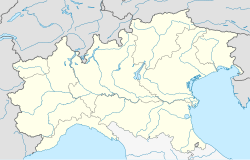This article has multiple issues. Please help improve it or discuss these issues on the talk page . (Learn how and when to remove these messages)
|
Milano Rogoredo | ||||||||||||||||||||||||||
|---|---|---|---|---|---|---|---|---|---|---|---|---|---|---|---|---|---|---|---|---|---|---|---|---|---|---|
 | ||||||||||||||||||||||||||
| General information | ||||||||||||||||||||||||||
| Location | Via Cassinis 83, Milan Italy | |||||||||||||||||||||||||
| Coordinates | 45°26′01″N09°14′21″E / 45.43361°N 9.23917°E | |||||||||||||||||||||||||
| Owned by | Rete Ferroviaria Italiana | |||||||||||||||||||||||||
| Operated by | Centostazioni | |||||||||||||||||||||||||
| Line(s) | Milan–Bologna HS Milan–Bologna Milan–Genoa Passante | |||||||||||||||||||||||||
| Distance | 9.567 km (5.945 mi) from Milano Centrale 208.751 km (129.712 mi) from Bologna | |||||||||||||||||||||||||
| Tracks | 13 | |||||||||||||||||||||||||
| Train operators | Trenitalia Trenord | |||||||||||||||||||||||||
| Connections | ||||||||||||||||||||||||||
| Construction | ||||||||||||||||||||||||||
| Architect | Angelo Mangiarotti | |||||||||||||||||||||||||
| Other information | ||||||||||||||||||||||||||
| IATA code | IMR | |||||||||||||||||||||||||
| Fare zone | STIBM: Mi1 [1] | |||||||||||||||||||||||||
| History | ||||||||||||||||||||||||||
| Opened | 1862 | |||||||||||||||||||||||||
| Electrified | 1938 | |||||||||||||||||||||||||
| Services | ||||||||||||||||||||||||||
| ||||||||||||||||||||||||||
| ||||||||||||||||||||||||||
Milano Rogoredo( IATA : IMR) is a railway station in Milan, Italy. It is one of the key nodes of the Milan suburban railway service as the southern gateway of the Milanese urban network.




